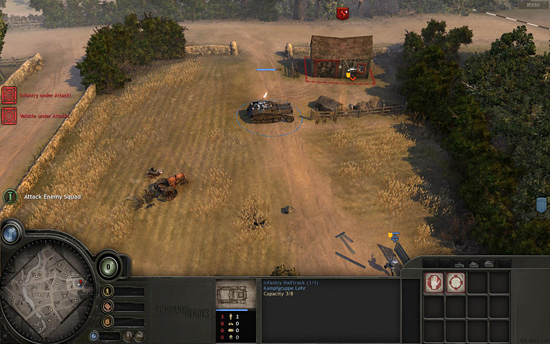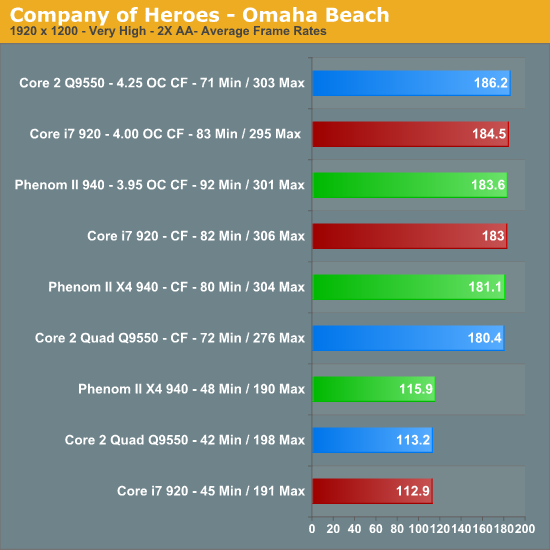CrossFireX and the Phenom II X4 940 – Competitive or Not?
by Gary Key on February 2, 2009 12:00 AM EST- Posted in
- Motherboards
Company of Heroes: Opposing Fronts

The oldest title in our test suite is still the most played. CoH has aged like fine wine and we still find it to be one of the best RTS games on the market. We look forward to the Tales of Valor standalone expansion pack this spring. In the meantime, we crank all the options up to their highest settings, enable AA at 2x, and run the game under DX9. The DX10 patch offers some improved visuals but with a premium penalty in frame rates. We track a custom replay of Able Company’s assault at Omaha Beach with FRAPS.

Just like our previous test results, we have very similar single card scores at 1680x1050. In this particular game, the Phenom II X4 940 offers the best minimum frame rates in each benchmark when compared to the Q9550 and surpasses the i7 in two tests. Only when the platform is overclocked do we see the Q9550 ahead of the Phenom II in average frame rates, a small 3% to be exact. However, the Phenom II has a 13% advantage in minimum frame rates.
Adding a second card for CrossFire operation improves average frame rates by 45% and minimum frame rates by 49% for the Phenom II. The Intel Q9550 has an improvement of 44% in the average and 81% in minimum frame rates. The Core i7 average frame rates improve by 48% and minimum rates increase 76%. Overclocking our processors resulted in a 5% average improvement in frame rates for our collective group, indicating we are largely GPU limited.
During testing, the Intel systems would generate minimum frame rates in the 23~24fps range on a couple of runs and then jump to their current results on the others. We noticed this in game play also; the Intel systems would hitch and pause at times. We would shutdown the game, clear the prefetch folder, and reboot. The game would operate fine in the next series of testing, though we still had stuttering in intensive ground scenes at times. We tried new images, different CPUs, memory changes, and the Sapphire HD 4870 cards with the same results. The Phenom II 940 had extremely stable frame rates in each test and action was very fluid during game play.

Lather, rinse, and repeat: the 1920x1200 numbers follow the same performance pattern once again - not that we expected anything different. Nevertheless, it is getting boring mentioning that same fact on every page. In single card testing the Phenom II 940 is 2% faster in average frame rates and 14% ahead in minimum frame rates compared to the Q9550. CrossFire results barely favor the Phenom II in average frame rates while minimum frame rates are about 8% better than the Q9550.
The i7 shows its strength in CrossFire testing in both average and minimum frame rates. We only experienced the previously mentioned drop in minimum frame rates a couple of times with i7 but it was still noticeable. The Q9550 finishes first again in average frame rates when overclocked but falls about 29% behind the Phenom II 940 in minimum frame rates.
Adding a second card for CrossFire operation improves average frame rates by 57% and minimum frame rates by 66% for the Phenom II. The Intel Q9550 has an improvement of 59% in the average and 71% in the minimum frame rates. The Core i7 average frame rates improve by 62% and minimum rates increase 82%. Overclocking our processors only improved frame rates 2% on average as we continue to be GPU bound at this resolution.
Now that we have discussed the numbers, what about the game play experience? As we alluded to earlier, the Intel platforms had problems with minimum frame rates throughout testing - not just in the benchmarks, but also during game play in various levels and online. We have not nailed it down yet, but we have noticed this problem consistently. In contrast, the Phenom II X4 940 had rock solid frame rates and offered the smoothest game play experience. The problem is very likely driver related in some manner (as the man who helped to start DirectX once put it, "the drivers are always broken"), but nevertheless this is an issue on the two Intel platforms.










68 Comments
View All Comments
megabuster - Monday, February 2, 2009 - link
If it's not too troublesome next time please include a few pictures of your hardware set up. :)none12345 - Monday, February 2, 2009 - link
There are errors in the benchmark charts on page 9....and maybe other pages..In the first chart you have the overclocked 9550 CF at the top of the chart, yet if you look at the min and max frame rates it is NOT the top performer, the core i7 beats it with 5 more min frames and 12 more max frames. The overclocked phenom ii cf shoudl also beat it with 11 higher min frames tho 13 less max frames.
In the second chart, the clear winer by the min/max frames is the overclocked phenom ii CF, it had a 9 higher min fps and 6 higher max fps yet its rated lower then the core i7. It had 21 more min fps yet only 2 less max fps then the 9550 but was ranked way lower.
Your score or min/max numbers are fubar...something is really wrong with those charts.
Maybe some of the other charts are messed up too, but this page stood out like a sore thumb.
Gary Key - Monday, February 2, 2009 - link
The charts are sorted by Average Frame Rates, unfortunately our engine does not allow multiple sorts on values. Let me see if I can do something different in the SLI article with an Excel chart, or I might just separate all the values into individual charts..7Enigma - Tuesday, February 3, 2009 - link
Gary, Let me just throw my opinion in to keep it sorted by average frame rates.That is probably the most important data point (next to possibly minimum) and so is a good way of ranking. I will thank you again and ask that all future reviews use your format of showing all 3 data points as it is very important in determining the better card for a specific game at a specific resolution/detail setting.
balancedthinking - Monday, February 2, 2009 - link
The Phenom II massively gains gaming performance with an overclocked Nortbridge because it directly boosts the cache performance.Reviews like the one from the german site p3d showed an increase in gaming performance worth 300-500mhz core frequency for an overclock of only 400 mhz NB frequenzy!
The NB runs stock @ only 1800 mhz. Good overclocks are in the range of 2600 - 2800mhz. Imagine the performance that is missing in the OC results from anand!
That is why the Q9550 can pull ahead when overclocked, because due to architecture, the cache gets overclocked too wenn you raise the reference clock.
The Phenom II 940 offers great potential when tweaking the NB clock but you have to do it manually in contrast to Q9550!
So please Anand, redo the Phenom II 940 OC tests with the Northbridge frequency maxed out. Only that would be a fair comparison.
Gary Key - Monday, February 2, 2009 - link
The NB frequency is at 2486MHz in these tests. I have it listed on page two now. I could not go higher and maintain this clock speed in Vista 64. Raising the NB speed to 2712 meant lowering CPU speed to 3842MHz. I test both values and our 3955/2486 combo performed the best.Kiijibari - Monday, February 2, 2009 - link
Perfect :)Thx a lot.
Kiijibari - Monday, February 2, 2009 - link
I agree, an info concerning the NB clock of the Phenom2 is missing.@anandtech: Please add it.
cheers
Kiiji
Kiijibari - Monday, February 2, 2009 - link
From the article:"(17.5x226, DDR2-1205, 5-5-5-18)"
That means, that the NB was clocked with 2034 MHz, if nobody changed the default multiplier 9
CPUGuy - Monday, February 2, 2009 - link
balancedthinking,Thanks for providing this tidbit of information regarding how cache is overclocked on the Intel vs AMD CPUS. If this review is based on what you said then it should be amended for re-testing.